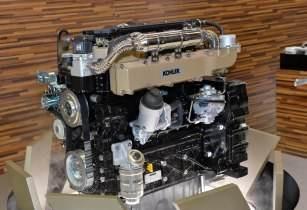Kohler Engines, a manufacturer of petrol and diesel engines, has launched a 3.4 litre KDI 3404 engine with Stage V-ready after-treatment
According to company sources, the KDI 3404 model completes the platform of KDI diesel engines. The KDI series is a complete range from 30 to 100 kW with three different engine sizes – the 1.9 L, the 2.5 L, and now the 3.4 L.
“The decision to use cutting-edge technology ensures all the models meet current emission standards without the use of a particulate filter. This is made possible by the high-pressure common rail injection system (2000 bar) offering extremely clean combustion when it is combined with four valves per cylinder, with G3S solenoid-type injectors for an extremely precise supply of fuel during the injection process and with the use of an electronically-controlled EGR valve for the recirculation of the right amount of exhaust gas, liquid cooled by a water/air heat exchanger,” stated company officials.
The KDI 3404 reaches 100 kW of power at 2,200 rpm; similarly it reaches 500 Nm maximum torque at 1,400 rpm. “These values rank among the ‘best in class’ in their target segment and are matched by their high torque reached at minimum rpm: the KDI 3404 reaches 412 Nm at just 1,000 rpm, enabling demanding work cycles at low rotation speeds, reducing fuel consumption by up to 10 per cent while significantly limiting noise levels. The perfect integration of the turbo, engine and electronic control unit guarantees an immediate response to variations in load, yet another benefit for productivity and operating fluidity, and enabling 15 per cent higher levels of machine productivity compared to leading competitors,” added the company.
The KDI 3404 claims to offer maximum efficiency in terms of the cost of ownership – minimum guaranteed maintenance intervals of 500 hours due to clean combustion without the need for a particulate filter (no DPF).
According to the management, the innovative injection system with a high-pressure common rail system 4 valves per cylinder, fixed geometry turbo, and EGR valve make it possible to reach standards of performance that are usually seen with higher displacement engines (specific power: 30 kW/L; specific torque: 150 Nm/L) all achieved without the requirement for a DPF. As a result, OEMs can replace the higher displacement engines in their projects with versions that have a considerably smaller footprint to reduce consumption without necessarily redesigning their application or, in the case of new machines, designing smaller engine housings leading to improved operator visibility and better productivity and safety.
The lack of a DPF helps to increase productivity for the end user who no longer has to slow down the work cycle because of the regeneration process as well as making installation easier as there is no longer any need to adopt expensive safety measures to counter excessive heat loss and prevent fire hazards.
The two lateral auxiliary power take offs (PTO) (SAE A and SAE B) offer versatility, engineered to deliver maximum engine power and simplify integration with the hydraulic system of the various applications, reducing the space taken up by the machines. The ‘bedplate’ architecture (crankcase and sub-crankcase) used for the engine block and its counter-rotating crankshafts also ensure minimum levels of vibration and noise.
“The special design of the KDI 3404 makes it the slimmest engine in its class, particularly important for agricultural applications where engines are placed on the front axle and have to be compact sized with less width to give farming vehicles a better turning radius, thus making maneuvering much simpler,” said Kohler.
In configurations above 56 kW, the KDI 3404 engine complies with Stage IV - Tier 4 Final exhaust gas standards because of the use of SCR (selective catalyst reduction) to abate the Nox in the exhaust fumes. The SCR system contains the DOC (diesel oxydation catalyst), the mixing pipe and the SCR in a single piece of equipment. The engine is ready for Stage V after-treatment.




